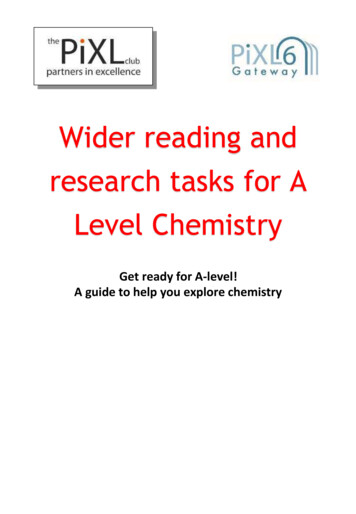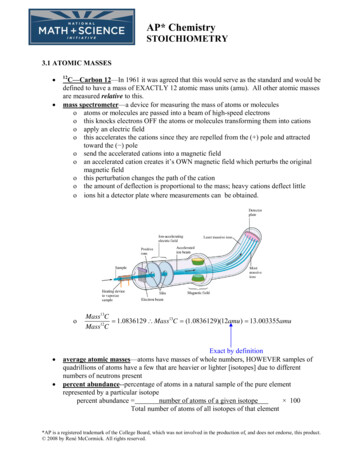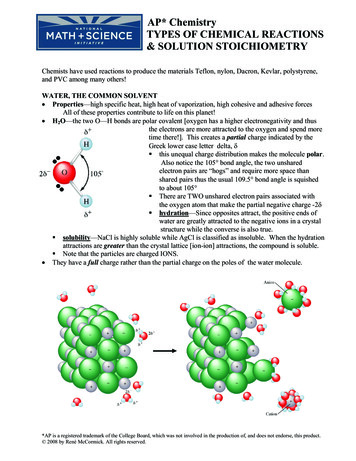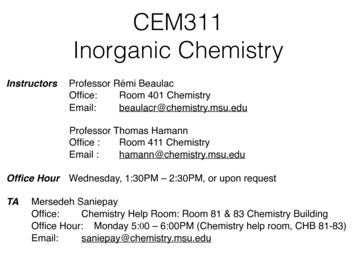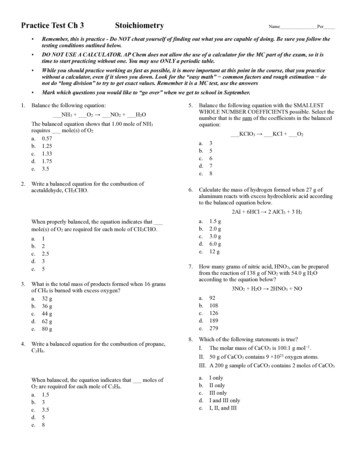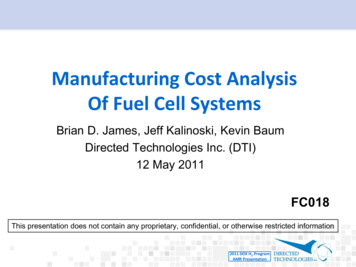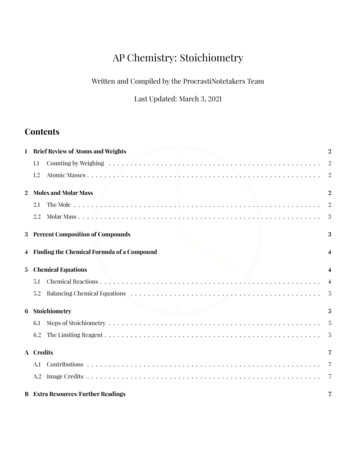
Transcription
AP Chemistry: StoichiometryWritten and Compiled by the ProcrastiNotetakers TeamLast Updated: March 3, 2021Contents1Brief Review of Atoms and Weights21.1Counting by Weighing . . . . . . . . . . . . . . . . . . . . . . . . . . . . . . . . . . . . . . . . . . . . . . . . .21.2Atomic Masses . . . . . . . . . . . . . . . . . . . . . . . . . . . . . . . . . . . . . . . . . . . . . . . . . . . . . .22 Moles and Molar Mass22.1The Mole . . . . . . . . . . . . . . . . . . . . . . . . . . . . . . . . . . . . . . . . . . . . . . . . . . . . . . . . .22.2Molar Mass . . . . . . . . . . . . . . . . . . . . . . . . . . . . . . . . . . . . . . . . . . . . . . . . . . . . . . . .33 Percent Composition of Compounds34 Finding the Chemical Formula of a Compound45 Chemical Equations45.1Chemical Reactions . . . . . . . . . . . . . . . . . . . . . . . . . . . . . . . . . . . . . . . . . . . . . . . . . . .45.2Balancing Chemical Equations . . . . . . . . . . . . . . . . . . . . . . . . . . . . . . . . . . . . . . . . . . . .56 Stoichiometry6.15Steps of Stoichiometry . . . . . . . . . . . . . . . . . . . . . . . . . . . . . . . . . . . . . . . . . . . . . . . . .56.2 The Limiting Reagent . . . . . . . . . . . . . . . . . . . . . . . . . . . . . . . . . . . . . . . . . . . . . . . . . .5A CreditsA.17Contributions . . . . . . . . . . . . . . . . . . . . . . . . . . . . . . . . . . . . . . . . . . . . . . . . . . . . . .7A.2 Image Credits . . . . . . . . . . . . . . . . . . . . . . . . . . . . . . . . . . . . . . . . . . . . . . . . . . . . . .7B Extra Resources/Further Readings7
AP Chemistry11.1StoichiometryBrief Review of Atoms and WeightsCounting by WeighingHow do we count the number atoms in a certain amount of substance? It is near impossible to count the atoms byhand or even with a sophisticated counting machine. Instead, the number of atoms is determined by weight. Thenumber of atoms can be determined by dividing the total mass of a substance by average atomic mass.Avg. mass Total Massnumber of "things"1.2 Atomic Masses Modern atomic mass is based on 12C, otherwise known as carbon-12. It is defined to have an atomic weight of 12amu – all other elements are based on this isotope of carbon. A mass spectrometer is one of the more accurate for comparing masses. The device launches a beam of highenergy electrons that knock electrons off of atoms, forming positive ions. Electric fields then accelerate ions intomagnetic fields. Deflection amounts determine mass. (Lower deflection levels indicate higher masses) Then itwill take ratios. For example, C Mass 12 1.0836Mass 13C Mass 13C (1.0836)(12 amu) 13.003355 amu The atomic mass is actually the average atomic mass of all the ions The counting by weighing method works if you know the average massnXM1 P1 M2 P2 M3 P3 . Mn Pn Average Mass 100M 1 Pii 1100(1)– In the equation above, the Mi ’s refer to the atomic masses of the isotopes of a certain element and the Pi ’srefer to each isotope’s relative abundance. For example, one isotope of lead (Pb) may have atomic weight206 and occur about 22% of the time. So, we would plug in for one of the Mi Pi , (206)(22).EXAMPLE 1: Copper (Cu) occurs in nature as 63Cu and 65Cu, with an abundance rate of 69.09% and 30.91%, respectively. Find the average atomic mass of copper.SOLUTION 1: First, let’s find the individual atomic weights of the isotopes.63Cu 62.93 amu, 65Cu 64.93 amu.(69.09%)(62.93 amu) (30.91%)(64.93 amu) 63.55 amu1002 Moles and Molar Mass2.1The MoleA mole is a quantity defined to be 6.022 102 3 units of something. It is also known as Avogadro’s Number.2
AP ChemistryStoichiometry If a sample of an element has a mass equal to its atomic mass, then there is 1 mole of that specific element; this issimply a consequence of how the mole is defined.EXAMPLE 2: Americium elements have a mass of 243 amu. Find the mass of 6 Americium atoms, in grams.SOLUTION 2: First, we want to find the total mass in amu, so we set up with dimensional analysis.6 atoms 243amu 1.46 103 amuatomThen, we will convert from amu to the SI standard grams. The conversion factor for this is 1 gram : 6.022 1023 amu1g 1.46 103 amu 2.42 10 21 g6.022 1023 amu2.2 Molar Mass In the formula for a chemical compound, the subscripts show the molar ratio between individual components ofthe compound. The molar mass is defined to be the mass of one mole of a substance. Remember that ionic compounds do not contain molecules. Rather, the units we use are called "formula units".EXAMPLE 3: Suppose we have a substance with the formula C10 H6 O3 . What is (a) the molar mass and (b) the numberof moles in 1.56 10 2 g of C10 H6 O3 ?SOLUTION 3: (a) We can calculate the molar mass by adding 10C 6H 3O where the letters represent the atomicweight. This would yield 10(12.01) 6(1.008) 3(16.00) 174.1g .For part (b), we would perform dimensional analysis (using our answer from the previous part):1.56 10 2 g 31 mole 8.96 10 5 g174.1 gPercent Composition of Compounds The composition of compounds is described in terms of the number of constituent atoms or mass percent.EXAMPLE 4: Take a look at ethanol (C2 H5 OH). What is the mass percent of each element in ethanol?SOLUTION 4: First, we calculate the mass of each element in one mole of ethanol: mass C : 2 12.01 24.01 g mass H : 6 1.008 6.048 g mass O : 1 16.00 16.00 g total: 46.07 g3
AP ChemistryStoichiometryThen, we will calculate the percentages like such (note that the sum of the percentages will equal 100%) 24.02 g mass % C : 46.07 g 100 52.14% gmass % H : 6.04846.07 g 100 13.13% mass % O : 16.00 g 100 34.73%46.07 g4Finding the Chemical Formula of a Compound The formula for a compound can be determined experimentally by weighing the sample and proceeding to decompose said sample into its elements. We can also react it with water to produce things like N2 , H2 O, etc. Wewill illustrate this with an example.EXAMPLE 5: 0.1156 g of a unknown compound X containing carbon, hydrogen, and oxygen reacts with oxygen gas toproduce 0.1628 g CO2 and 0.1676 g H2 O. What is the chemical formula of compound X.SOLUTION 5: The molar masses of CO2 and H2 O are 44.01 g and 18.02 g, respectively. Now we will set up our dimensional analysis: 12.01 g C0.4470 g C 44.01 g CO2 0.16238 g CO2 0.04470 g C 0.1156 g unknown 38.67%C 2.016 g H0.01879 g H18.02 g H2 O 0.1676 g H2 O 0.01879 g H 0.1156 g unknown 16.22%H 100 (38.67 16.22) 49.11%NNow, we assume we have 100 grams of compound X to make the percentage calculations easier. We will calculate howmany moles of C, H, and N there are in 38.67 g of C, 16.22 g of H, and 49.11 g of N, respectively. These calculations wouldyield 3.22 moles of C, 16.09 moles of H, 3.220 moles of N. This ratio of C : H: N simplifies to 1 : 5 : 1. Therefore, the chemical formula of compound X is CH5 N .Empirical vs Molecular FormulasThe empirical formula for a compound is the simplest whole number ratio between respective elements. Themolecular formula for a compound is the exact formula for the molecule involved (this can be reduced to theempirical formula). The formula for the molecular formula can be stated as follows:MOLECULAR FORMULA EMPIRICAL FORMULA 55.1MOLAR MASSEMPIRICAL FORMULA MASS(2)Chemical EquationsChemical ReactionsA chemical reaction reorganizes atoms in a certain way to form products from set reactants. For example, the combustion of methane gas: CH4 O2 CO2 H2 O.Nothing is "created" nor destroyed" in the literal sense. The atoms are simply rearranged.4
AP ChemistryStoichiometryAs for the matter of balancing chemical equations, we have to make sure that each side of the reaction has the samenumber of atoms. For example, the reaction above, when balanced, is CH4 2 O2 CO2 2 H2 O.A chemical reaction can also give the physical state of the reactants and products. These states include gaseous (g),liquid (l), solid (s), and aqueous (aq). An example is: HCl(aq) NaHCO3(g) CO2(g) H2 O(l) NaCl(aq)5.2 Balancing Chemical Equations Before performing any stoichiometry, always make sure that the equation is balanced. When balancing, we only change the coefficients of the chemical compounds, not the identity of the chemicalcompounds themselves.6Stoichiometry6.1Steps of StoichiometryThe general steps of stoichiometry is:1. Balance the equation2. Convert the mass given (reactant or product) to moles3. Use the balanced equation to set up more ratios4. Use more ratios to calculate moles of desired reactant or product5. Convert from moles to gramsEXAMPLE 6: What mass of gaseous carbon dioxide can be absorbed by 1.00 kg of Lithium hydroxide?SOLUTION 6:1. 2LiOH(s) CO2(s) Li2 CO3(s) H2 O(l)g. 1kg of LiOH 1000 / 23.95 41.8 moles of LiOH2. LiOH is 23.95 mol3. For every mole of CO2 consumed, 2 moles of LiOH are consumed as well.4. 41.8 molesLiOH 5. 20.9 mol 44 gmol1 molCO22 molLiOH 20.9 mol CO2 9.20 102 g will be absorbed6.2 The Limiting ReagentLet’s start off with a metaphor for the limiting reagent: suppose we want to make a sandwich from bread, meat, andchess. Suppose a sandwich is made from 2 pieces of bread, 3 slices of meat, and 1 slice of cheese. Suppose we have 85
AP ChemistryStoichiometrypieces of bread, 9 slices of meat, and 5 cheese. In order to determine which ingredient constrains the amount of sandwiches we can make the most, we analyze how many sandwiches we could make by constraining one ingredient whilesupplying an infinite supply of the others. If we had an unlimited supply of meat and cheese, we can make 4 sandwiches. If we had an unlimited supply of bread and cheese, we can make 3 sandwiches. If we had an unlimited supplyof bread and meat, we can make 5 sandwiches. Therefore, since we can make the fewest number of sandwiches whenmeat was limited, meat is our limiting ingredient.In chemistry, this limiting reactant can be anything on the reactant side. A typical way to solve limiting reactant problems include imagining an unlimited supply of all the other reactants except one, and repeat this process for all thepossible limiting reactants. The reaction that produces the fewest moles of product will be the limiting reactant. Wewill see examples and worked out solutions on the example notes.In addition to reactants that might limit the reaction, we also have other factors that can hinder the total amount ofproduct produced. The theoretical yield is the maximum yield (products produced) given the initial measurements ofreactants. The percent yield is the percent of the maximum yield we actually get. The reason chemical reactions don’tgive the theoretical yield every time is because the world isn’t perfect. Sometimes the atoms don’t get exposed to eachother and remain inactive (Ex: reacting something solid with something liquid – the solid might not all react).6
AP utions Notes originally by Hannah Kunkel Edited and Converted by Austin WangA.2 Image Credits Clock: Veronica CruzBExtra Resources/Further Readings All resources mentioned retain the same licensing as the original creators intended. The ProcrastiNote Teamhas checked every single one of these to make sure that our usage of their materials remains within the legalrealm. If you are the owner of these materials and you believe there is a mistake in our citations, please contactus at official.procrastinote@gmail.com. Thanks! Other resources on ProcrastiNote! Organic Chemistry Tutor Playlist Khan Academy Chemistry7
AP Chemistry Stoichiometry If a sample of an element has a mass equal to its atomic mass, then there is 1 mole of that specific element; this is simply a consequence of how the mole is defined. EXAMPLE 2: Americium elements have a mass of 243 amu. Find the mass of 6 Americium atoms, in grams.



